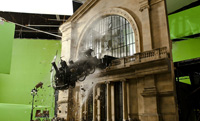
VFX supervisor Matthew Gratzner at New Deal Studios in Los Angeles led his practical effects
crew in the construction and destruction of the magnificent Montparnasse Railway Station
in ‘Hugo’ – all at 1:4 scale.
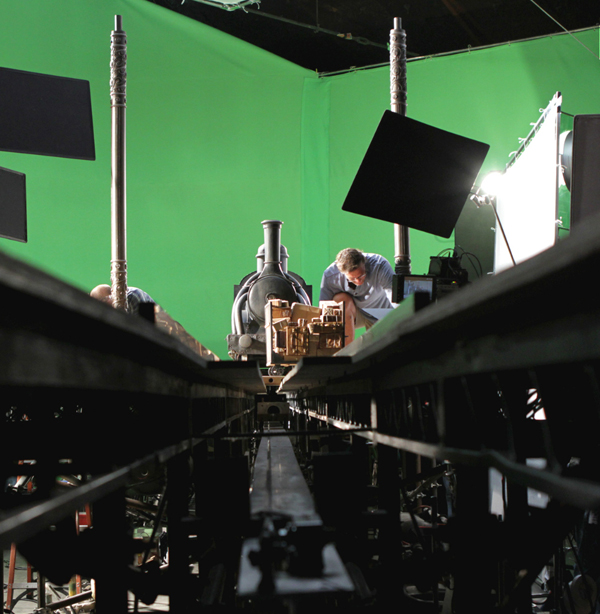 |
|
| Working on ‘Hugo’ meant another opportunity for Matthew to work with the production’s VFX supervisor Rob Legato. The two had previously worked together on ‘The Aviator’ and ‘Shutter Island’ among other films. ‘Hugo’ was also Matthew’s fifth project with director Martin Scorsese, although because it was shot in England, the New Deal team were not as involved during production as they usually are.
Historic Crash Matthew started planning his approach at once. “Our main challenge was to achieve this shot to look like a real train crash – with a real train and real station, and action that scales out correctly. So I decided to use the largest scale I thought would work within the confines of the stage and the other practical factors for the shoot, while meeting the director’s requirements for the story, and chose a scale of 1:4 .” This scale, resulting in a quarter-sized station and train, produced quite a large ‘miniature’. The station was about 20ft high and 25ft wide, and the train itself was 18ft long. In the process of building it, the crew had to engineer the materials, the mechanical effects and how it would perform and fall back to the ground - exactly as it did in the reference photo. In fact, this last point was probably the team’s greatest challenge. “This train has to behave exactly as the train behaved in 1895. Obviously, we had no running footage of the event to show us how the action actually unfolded. Therefore, using the dimensions of the train and our understanding of physics, we had to simulate the result,” Matthew said. |
|
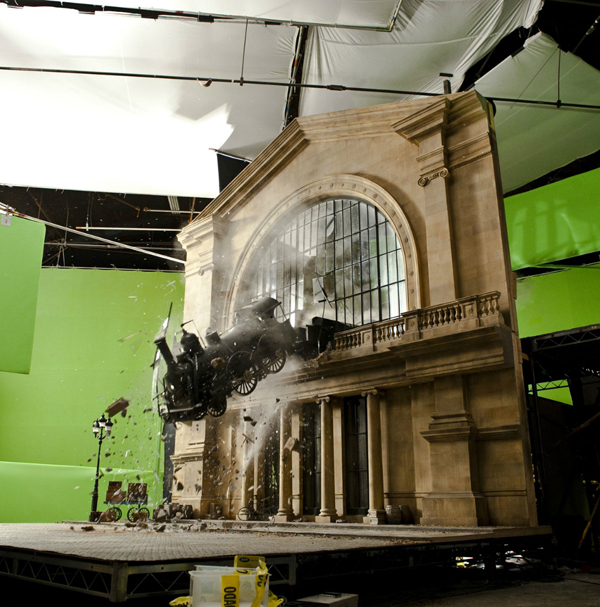 |
|
| Digital Beginnings “Our mechanical supervisor Scott Beverly engineered everything in SolidWorks first. This is our standard procedure for all projects – everything is built digitally first in SolidWorks for the mechanical effects and Rhino for construction to design the build and set proportions. Files in Rhino can be translated to a CAD-accurate blueprint.” Regarding accuracy and materials, New Deal does a tremendous amount of research for every project and keeps a substantial library. Matthew said that he and his business partner Ian Hunter at New Deal are “history fanatics”. They learned that trains of the 1890s were typically made of plate iron and were hand-built, and also identified materials that would effectively imitate iron when crushed, such as lead. “We used quite a bit of sheet lead on the crushed sections of the train. For the station itself we did some forensic, reverse engineering by looking at historical images and determining that certain parts were probably cast from a concrete type of material, others were of masonry or stucco, and the structure was possibly a stone block covered in stucco. Our method is to consider the period in which buildings were constructed and the common materials at the location, and try to imitate those materials for the model.” |
|
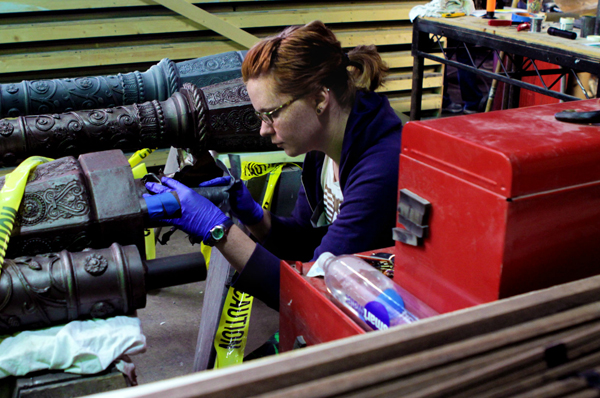 |
|
| Rare Breed Other than Weta and one or two companies in the UK, Matthew explained that New Deal is among the few companies that still build miniature effects, which he feels is unfortunate because it’s still a viable, effective way to help tell a story. To help clients understand their process, part of each project involves explaining that even if the crew designs a model digitally first, they still have to deal with physics and gravity – which may or may not be controllable. So they try to engineer and anticipate as much as possible, well in advance of the shoot. “We had done a lot of complete, full-scale testing of the train before we even shot the hero photography,” he said. “We had test versions of the model that we would run out of the station, made up of the actual wheels and substructure of the hero train but using dummy sections of train exterior over the top to practise destroying.” The train crashes through a huge curtain wall of glass. They knew that, in the era, the glass would be of a certain thickness and the framework – the mullions holding the glass together – was probably made of steel. They simulated this with hand-soldered lead and hand-set the glass panes, preparing for it to shatter. The mechanism used to launch the train through the station was a giant pneumatic cylinder that had a series of cables normally used for flipping and throwing full-scale automobiles. When complete and ready for action, New Deal’s train weighed about 700lbs, or 320kg, which required a fair amount of pressure and throw from the cylinder. Inevitably, the event had to be staged twice – that is, they built one station and one train, but with replaceable parts to cover both takes. |
|
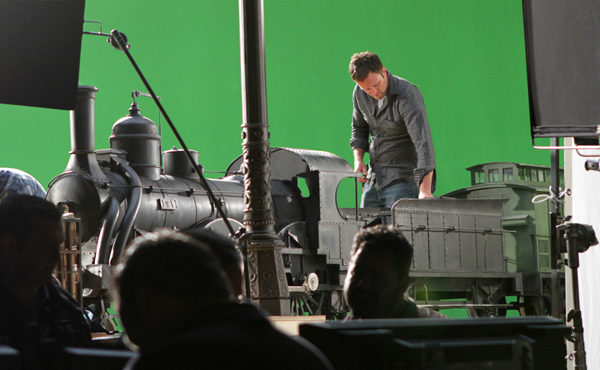 |
|
| Action Template After Rob’s first contact, once New Deal were handed the award, the development, build and testing took just eight weeks. The stages were research, engineering, digital drawing, construction, painting and finishing, and finally the shoot itself. “Usually, we don’t really have a great deal of time on projects. However nothing is off-the-shelf for this kind of work - there are no 1:4 scale train shops in California,” Matthew joked. Working with the visual effects side of the production was important, and aided by the fact that Matthew knew and had already worked with Pixomondo’s VFX supervisor Ben Grossmann as well. Ben showed him the previs well before New Deal commenced their actual work so that Matthew could begin planning for the requirements. Ben had a digital train and station model in Maya showing the vision for the action of the sequence. “Later the Art Department provided drawings that we could use as the basis for the Rhino files, which were in turn converted to accurate Maya files and given to Pixomondo to build their digital models from. Ben also took stills of our finished train and station in different lighting scenarios, as a record of real textures and real, interactive light.” The previs was excellent. New Deal could use it as the rough template for action, especially for camera angles and lensing, but then went back and refined the details. “When building a Maya model of a train, you don’t really need to add every last detail, as we did because we had to build it physically. Model Crew Chief, Forest Fischer, supervised the overall model build. Accurate Magic |
|
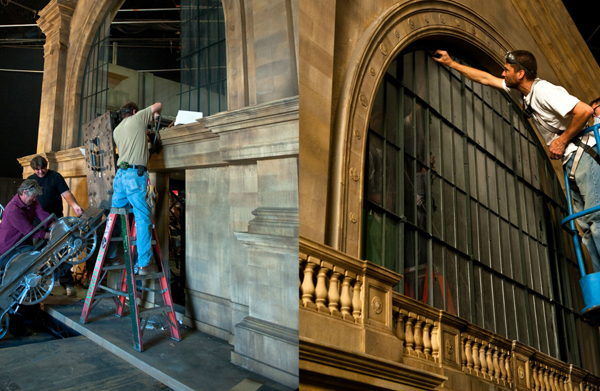 |
|
| “I’m a stickler for accurate previs generally, because if you are using it for 1st unit action, miniatures or stunts, you really need to understand the cameras being used, the equipment they will be rigged to, and the confines of the locations and stage. I sometimes encounter previs in which someone has inadvertently buried the camera in the floor or wall, unaware that some angles can’t be achieved practically. Pixomondo was quite careful about avoiding those anomalies.”
Adding to the crew’s enthusiasm for the project was the chance to build some of the station elements such as baggage carts, a bench with set dressing, and support posts for the ceiling that the train crashed through for interior shots of the station. He said, “We also built a news kiosk with hundreds of scaled period magazines. New Deal’s construction and engineering team was only about 20 to 25 throughout the project, depending on the stage they were in, plus the artists. “The talent of the model makers, sculptors, metal fabricators and mechanical engineers is always exciting for me because this work is really the last ‘movie magic’ remaining. Virtually none of the shots we’ve created for films, has anyone guessed was a model. They look real because they are real. Having said that, digital animation, lighting and shaders are fantastic and the digital tools you can use to blend practical effects like miniatures with live action have become astounding.” |
|
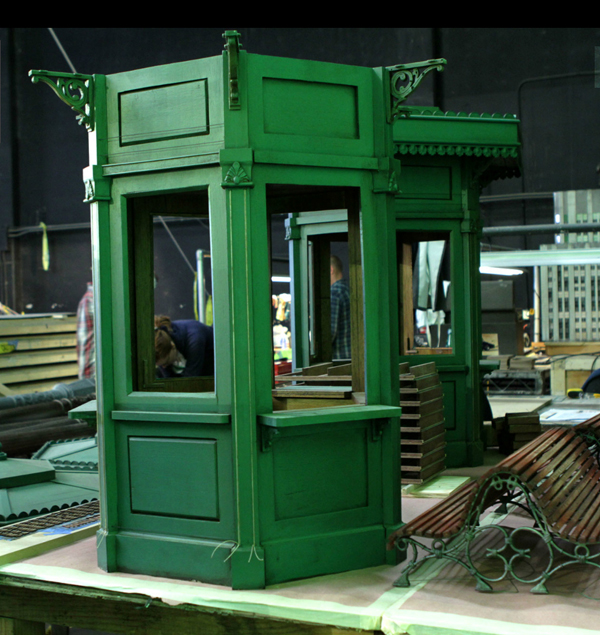 |
|
| Scaling Intuition After many years and experience in this work, the choice of scale for models has become partly intuitive, partly determined by formula for Matthew. “I consider, how big does a model have to be to look real and how small does it have to be to fit on the stage? For destruction models, you want to build as large as possible without breaking the budget or the confines of the shoot location. For motion control or static models, size isn’t so critical – you can always shoot at a reduced frame rate to enhance depth of field. “In this case I chose quarter scale because the real train, an 1895 steam locomotive, was 25ft long. If that locomotive had been contemporary with the period that the Hugo story took place, the 1930s, the train would have been about 60 per cent longer and required us to use a smaller scale. The model would have been about 10ft instead of 6 ½ft and harder to manipulate and work with. In short, it had to be big enough to achieve the correct action but small enough for the stage. Another advantage of the 1:4 scale was the need to shoot in stereo with the Pace Cameron rig like the rest of the production, except with the interocular distance set for quarter scale. New Deal had shot some photographic elements in stereo for ‘Pirates of the Caribbean’ and some live action photography for ‘Resident Evil: Afterlife’ but never a detailed scale model. “That was pretty exciting. Instead of trying to do the shoot ourselves as we normally do, Rob Legato came in as the DP on this one, and we did all of the set up and provided all production support,” Matthew commented. |
|
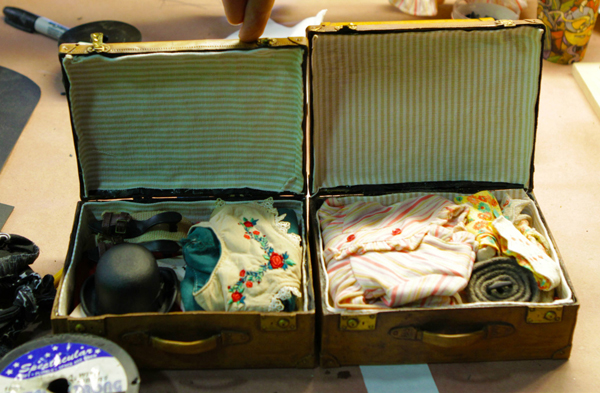 |
|
| Multiple Takes For the big shot of the train exiting the exiting the station through the glass curtain, two cameras were used and captured two takes, but for all the shots of the train inside the station crashing through floors, news kiosks and benches, they captured three separate takes of each event of the crash. “This means we supplied three news kiosks, three sets of luggage carts, nine sets of flooring – a lot of stuff! But we had to be sure of covering the whole sequence in the edit,” he explained. “Both the interior and exterior miniature shots were shot on green screen, so that action and background mattes could be pulled later.” “Most shots were captured in the first take, but we ran through all the materials we had built. Most everything had to be hand built as breakaway items but some things were moulded and cast, such as the suitcases which were thinly covered to resemble leather. The extra takes were also useful in the trailers, which had to be completed early on. Using miniatures not only provided something that looked real, but they could be done fast. Adding those extra angles to the shoot gave more scope for trailer shots as well as the movie itself.” Rob Legato set up his interior lighting to match 1st unit, and then created a scheme for the exterior shot. For the station exterior, which had mainly been created as a matte painting extension of the existing set by Matte World Digital, he devised a partly overcast, backlit scenario. Preparing for Composite To tie the crash sequence into shots surrounding the live action, plates were inserted of the station, of people running away, and of a single full-scale, breakaway model news kiosk, shot while a green screen-covered stand-in train crashed into it. Some train POV shots were also captured with a motion control camera. Matthew said, “Again, following the previs as a template, the production was able to line up shots in the edit to create a continuous sequence. When we were on set we would first block in the shot per the previs, and then tighten it up to match what had actually been captured in the live action. We had a mixer on set to switch between the live action plates and the miniature, particularly on the interior station where the miniature shoot might form the foreground and mid-ground, in front of live action shot on a partial set, in front of a matte painting. “In the extreme foreground might be separate photographed elements of actors running past. If everything had been done correctly, it would all line up and work in the composite. It meant keeping an eye on scale and especially on perspective – one of the hardest, but most important, things to watch in a layered composite.” Stairway of Fire Pyrotechnic supervisor Ritchie Helmer and his team created a back-blast within the stairway to create a fireball rushing toward the viewer. He used butane for the burst of flame, which burns relatively cool to avoid destroying the set, most of which was made of wood and skinned in dry wall, or sheetrock. All mouldings and detail were cast from heat resistant urethane resin, making the set was as fireproof as possible for multiple takes. www.newdealstudios.com |
|
| Se also:HUGO CAPTURES MOVIE MAGIC | |


















